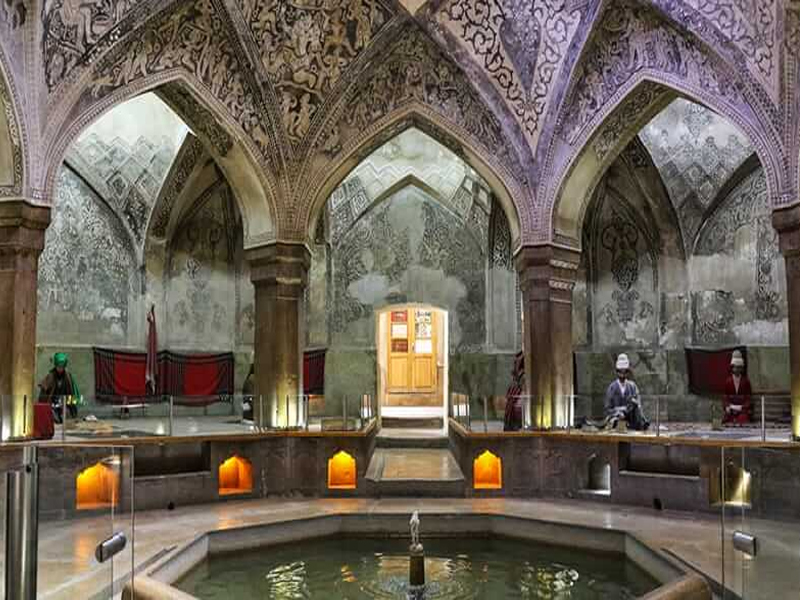In the past, due to the absence of baths in houses, people used public baths for washing and cleanliness. Besides being a place for hygiene, baths were also a venue for cultural and social interactions. This fact has made the architecture of ancient baths distinctive and remarkable. Nowadays, fewer people use public baths, and these magnificent structures with eye-catching decorations have been transformed into ancient attractions that attract the attention of many tourists. If you are also interested in these ancient structures, join Eligasht to get acquainted with 10 examples of ancient baths in Iran.
Book Iran Air flights from London to Tehran and Tehran to London with Eligasht UK:
Sultan Amir Ahmad Bath
Sultan Amir Ahmad Bath in Kashan is one of the masterpieces of Iranian architecture. This ancient bath, with an area of 1,000 square meters, was built during the Seljuk period. The resilience of this ancient bath is so high that even the earthquake of 1157 SH (Solar Hijri) couldn’t destroy it. Unfortunately, in this 6.2 magnitude earthquake, a significant part of residential houses and ancient monuments in Kashan were completely devastated.
The interior of Sultan Amir Ahmad Bath is beautifully decorated with blue, white, and yellow plasterwork, and its rooftop is one of the most iconic ancient sites in Kashan, often featured in many photographs. The different sections of this ancient bath include the octagonal hall, the vestibule, the dressing room, the connecting corridors, the Shah’s seat, the hot room, the treasury, the sanitary facilities, the cleaning room, and two water wells.
Some believe that the dressing room of Sultan Amir Ahmad Bath belongs to the Qajar period, while others suggest that the present bath was built in the Qajar era, in 1254 SH, on the ruins of the old bath. Interestingly, the name of this bath is derived from an Imamzadeh (a shrine) located in the vicinity of this building.
Address of Sultan Amir Ahmad Bath: Alavi Street, Sultan Amir Ahmad Alley, Kashan City
Fin Bath, the most famous ancient bath in Kashan
Fin Bath is the most renowned ancient bath in Kashan. This public bath is well-known among tourists due to an important ancient event that took place there, namely the assassination of Prime Minister “Amir Kabir.” Fin Bath is located in the southern part of Fin Garden in Kashan and consists of two sections called the small bath and the large bath. The origin of the small bath dates back to the Safavid period. This section was built simultaneously with the initial construction of Fin Garden and was specifically used by the servants. The large bath was added to the complex during the Qajar period by the order of Fath Ali Shah, and it was usually used by the nobility.
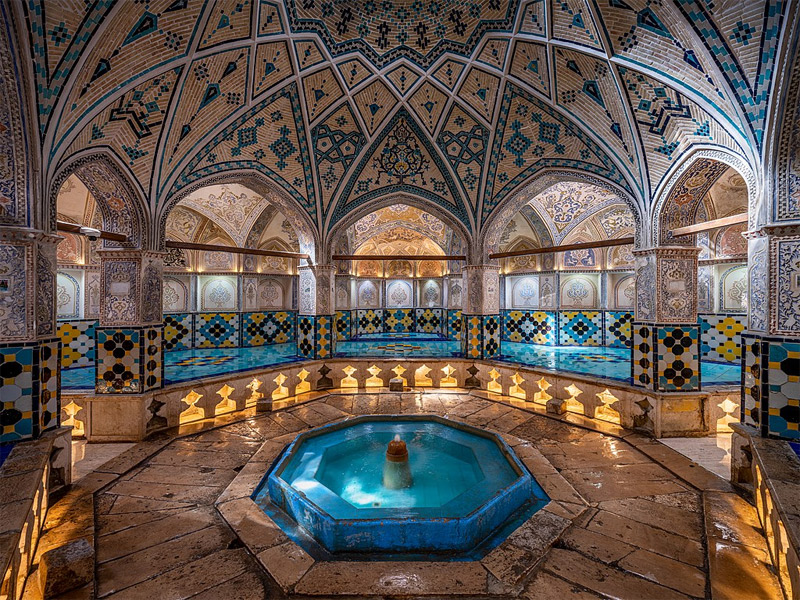
Fin Bath features an entrance, a warm room, a pool, a reservoir, a cleaning area, a dressing room, water channels, and a basin. The construction of the walls of this ancient bath involved the use of sand, saruj, and lime. In 2011, Fin Bath, along with Fin Garden, was registered as one of the nine Iranian gardens on the UNESCO World Heritage List.
Address of Fin Bath, Kashan: Central District, Amir Kabir Street, Kashan.
Sheikh Bahai Public Bath in Isfahan: A Marvel of Artistic and Engineering Excellence
Sheikh Bahai Public Bath in Isfahan astonishes tourists with its marvelous architecture and engineering. This bath is one of the most unique ancient baths in Iran, which used to be heated with just one candle in the past. Interestingly, even after many years since the construction of this bath, scientists have been unable to fully discover the secret of this place. They believe that the heating system of this ancient bath in Isfahan is an engineering masterpiece created by Sheikh Bahai, utilizing the laws of physics and chemistry.
Based on conducted studies, some believe that there was a ceramic pipe system beneath the bath that naturally drew gases like methane and sulfur oxides into the reservoir of the bath, causing it to heat up.
The architecture of Sheikh Bahai Bath is similar to that of other ancient baths in Iran, with the only difference being the fire chamber and the supply of fuel for heating. Various parts of this bath include two large dressing rooms, a pool, several reservoirs, and water storage areas.
Address of Sheikh Bahai Bath, Isfahan: Isfahan Province, Abdul Razzaq Street, Sheikh Bahai Alley.

Four-Season Bath of Arak, an ancient bath with four separate sections
Due to the four seasons of Arak, each section of this bath was used in one of the seasons in the past. An interesting fact about the Four-Season Bath of Arak is the existence of a dedicated section for religious minorities. According to the transmitted stories, the founder of this structure saw a Jewish mother bathing her child in an open space during winter. He asked the mother why she was bathing her child in the cold, and then realized that religious minorities were not allowed to use public baths. For this reason, when constructing the bath, a section was designated for religious minorities.
The history of the Four-Season Bath of Arak dates back 120 years. It was built by Haj Ibrahim Khan Khansari on a 1600-square-meter plot of land. Some of its special features include decorative and colorful tiles.
Among the ancient baths of Iran, the Four-Season Bath of Arak is the largest and includes sections such as the men’s and women’s dressing rooms, the entrance hallway, the eight-room complex, private and public hot rooms, a water reservoir, and a treasury. Currently, this bath has been converted into an ethnographic museum.
Address of Four-Season Bath of Arak: Arak, Shahid Dr. Beheshti Street, between Haft Tir Square and Shahid Square
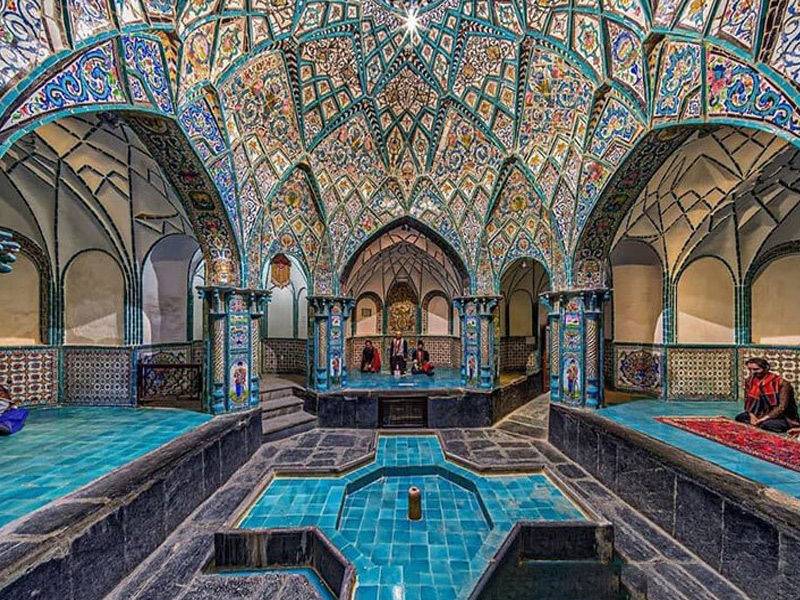
Givi Stone Bath in Ardabil, the oldest bath in Iran
Givi Stone Bath in Ardabil is the oldest bath in Iran. This bath, locally known as “Dash Hamami,” is a five-meter-long room carved into a mountain. Givi Stone Bath is located in the southeast of the city of Givi, next to the Givi River, and has an entrance with two cold and hot springs. An interesting fact about this bath is that the spring water is rich in mineral salts, so people do not need to use soap and shampoo while bathing.
The entire space of Givi Stone Bath is covered with natural stone, and water flows from three points with different temperatures. Unfortunately, there is no precise information about the construction and history of this bath. Today, this fascinating complex is traditionally used by locals and tourists.
Address of Givi Stone Bath: Ardabil, Kowsar (former Givi), east of Givi city, 300 meters from the end of the municipal services area of Givi, next to Givi River
Related post
Ali Qapu Mansion, the Gateway to the Splendid World of Safavid
An Eternal Fire in Iran that Has Burned for 1500 Years!
Ganjali Khan Bath in Kerman, one of the most attractive ancient baths in Iran
Ganjali Khan Bath in Kerman is one of the most attractive ancient baths in Iran, built in 1020 AH (during the reign of Shah Abbas Safavi) by the order of Ganjali Khan, the ruler of Kerman. This bath is part of a large complex that includes a school, mosque, bazaar, and bath.
The dressing room of Ganjali Khan Bath has secluded corners and alcoves where visitors used to engage in conversations. The water supply of this bath comes from underground aqueducts, and the building itself is completely earthquake-resistant. The attractive features of this ancient bath include eye-catching tilework, brickwork inlays, ornate stone carvings, and impressive arches. Ganjali Khan Bath in Kerman has now been converted into an ethnographic museum.
Address of Ganjali Khan Bath in Kerman: Kerman Province, Kerman City, Kerman Grand Bazaar, Ganjali Khan Square
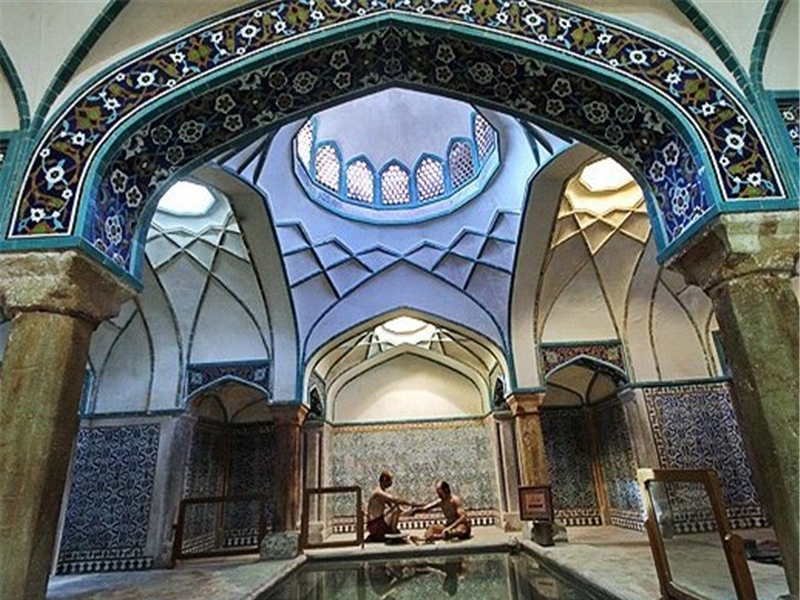
Vakil Bath, Kerman, Related to the Qajar Period
Vakil Bath in Kerman belongs to the Qajar period. This bath is another one of Iran’s ancient baths and is part of a larger complex called the “Vakil Complex.” Vakil Bath in Kerman was built in 1270 AH (Hijri calendar) by the order of Mohammad Ismail Khan Nouri, the ruler of Kerman at the time. Today, this attractive structure is used as a traditional tea house. It’s interesting to note that the design of this bath was inspired by Ganjali Khan Bath.
The architecture of Vakil Bath in Kerman bears a significant resemblance to the architecture of ancient baths in Iran, and its interior space is adorned with beautiful ceramics and tiles from floor to ceiling. It also has beautifully crafted stone basins. If you crave a delicious meal or tea after exploring Kerman’s bazaar, be sure to visit this bath.
Address of Vakil Bath in Kerman: Kerman, Taleghani Shiraz Street, in the middle of Kerman Bazaar, after Ganjali Khan Bath.
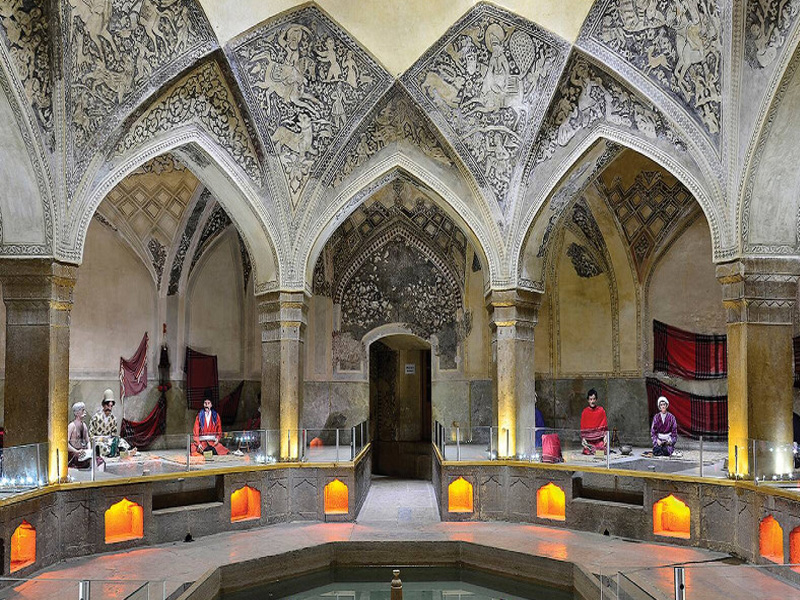
Navab Bath, One of Tehran’s Ancient Baths
Navab Bath in Tehran is one of the ancient baths of the city. Some believe it dates back to the Safavid period, while others attribute its construction to the Qajar period. In the oldest map of Tehran from the Safavid era, this bath is recorded as “Navab Bath.” Furthermore, the spatial layout and architectural elements of Navab Bath resemble the baths of the Safavid era. Various sections of this bath include the entrance, dressing room, intermediate door, octagonal hall, warm chamber, and treasury.
According to available records, the founders of this building were two sisters named Sara Hajar Khatun and Sara Sultan Khatun, and it was mostly used by high-ranking and well-known individuals in society. An interesting fact about Navab Bath is that it served as the location for one of the most famous Iranian movies, “Qeysar,” and the scene of Karim Abangol’s murder was filmed there.
Navab Bath in Tehran was registered as a national heritage of Iran in 2006 and is now recognized as one of Tehran’s ancient attractions.
Address of Navab Bath in Tehran: Tehran, Rey Street, Oudlajan Sharqi, Beyk Damghan Alley (Former Navab Bath Bazaar).
Khan Bath, Yazd, an Ancient Bath with Mythological Shahnameh Decorations
Khan Bath in Yazd is an ancient bath adorned with mythological Shahnameh decorations. At the entrance of this bath, there are beautiful sculptures and paintings depicting stories from Shahnameh (the Book of Kings) that captivate every viewer. Khan Bath is part of the Khan Complex, which includes a bazaar, a square, and the bath itself. It was built by Mirza Taghi Khan Bafghi, the head of the Khavanin family of Yazd, during the Qajar period (in 1212 AH). The different sections of this complex are connected through small and large entrances.
Khan Bath in Yazd, designed with Iranian architecture on a 1,170 square meter area, has various sections such as the treasury, dressing room, throne room, entrance, warm chamber, and a pool adjacent to the warm chamber. Today, this bath has been transformed into a restaurant and a traditional tea house, allowing tourists to taste the delicious cuisine and sweets of Yazd in this location.
Address of Khan Bath in Yazd: Yazd Province, Yazd City, Qiam Street, Khan Square, next to Molla Asghar Mosque.
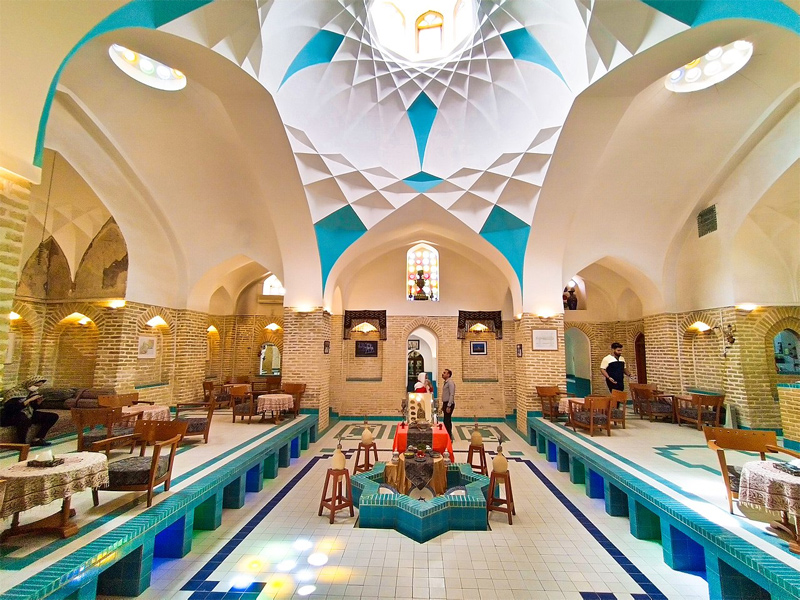
Vakil Bath in Shiraz, a relic of the Zand era
This bathhouse was built in 1187 AH (1773 CE) by the order of Karim Khan Zand on land with an area of 1400 square meters. Vakil Bath, like other ancient baths in Iran, has remarkable decorations and tile works. The building and decorations of this bathhouse were restored during the Qajar period, with some parts covered with Sarooj (traditional waterproofing material) and re-adorned.
Vakil Bath in Shiraz was operational until the second Pahlavi era but was closed after cracks appeared in the walls and ceiling. Restoration works in 1351 SH (1972 CE) made it usable again. After the Islamic Revolution, this bathhouse was converted into a tea house and restaurant, but after some time, Vakil Bath changed its function and became a museum open to the public.
Address of Vakil Bath Shiraz: Talghani Street, Shiraz.
Final words
As mentioned before, public baths in the past were not only places for bathing and cleanliness but also served as social and cultural hubs. Especially Iran’s historical baths, with their captivating decorations and visible artworks, were tranquil and secluded places where people could sit in different sections, engage in conversations, and socialize after bathing and cleaning themselves.
FAQ
1- What is the significance of historical baths in Iranian culture?
Historical baths hold great cultural significance in Iran. They were not only places for physical cleanliness but also served as social hubs where people from different walks of life would gather. These baths were important meeting places for conversations, storytelling, and even conducting business. They played a vital role in fostering community bonds and promoting a sense of well-being.
2- What are the distinctive features of Iranian historical baths?
Iranian historical baths are characterized by their unique architectural design and meticulous attention to detail. They typically consist of a series of interconnected chambers, including a dressing room, a warm room, a hot room, and a steam room. The architecture often showcases intricate tile work, vaulted ceilings, stained glass windows, and beautiful calligraphy. The baths were designed to provide a serene and relaxing environment for visitors.
3- Can historical baths still be visited in Iran today?
Yes, many historical baths in Iran have been preserved and are open to visitors today. These baths have been restored and converted into cultural and tourist attractions, allowing visitors to experience the traditional bathing rituals and appreciate the architectural beauty.
